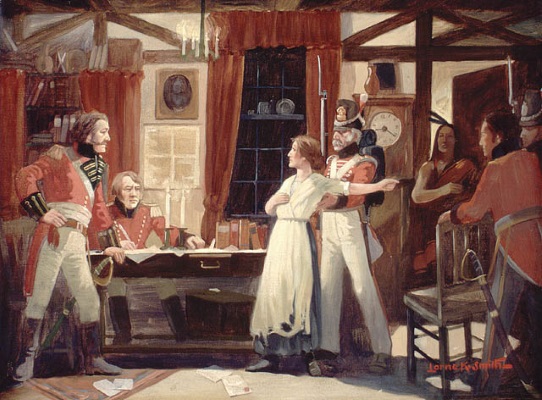
“Meeting Between Laura Secord and Lieutenant Fitzgibbon, June 1813,” by Lorne K. Smith, 1920.
June 21st marks the anniversary of Laura Ingersoll Secord’s 1813 trek to warn Lieutenant James FitzGibbon of American plans to launch a surprise on British troops at Beaver Dams and seize control of the Niagara Peninsula. Laura is one of Canada’s earliest heroines and today she is near-mythologized in Canadian history; she has two monuments dedicated to her, one at her grave site at Drummond Hill Cemetary and another at Queenston Heights. Her homestead in Niagara Falls is preserved as a heritage site and museum.
Today we’d like to take the opportunity to remember and honour this remarkable women, whose bravery above and beyond the call of duty during the War of 1812 earned her the distinction “the heroine of Beaver Dams.”
Laura Secord is most known for her now-famous 32 kilometer (20 mile) walk through American-occupied territory to warn British forces of an impending surprise attack. On the evening of the 21st of June, 1813, she became aware of the Americans’ plans. It is unclear how exactly she learned this information, though popular folklore says she overheard American soldiers discussing their plans as they ate dinner at her house. Because her husband, James Secord, was still recovering from injuries he had sustained at the Battle of Queenston Heights, Laura took it upon herself to take the long journey across back roads and dangerous, American-occupied territory to Short Hills (now Pelham, Ontario). It was there that she encountered a camp of allied Mohawk warriors who guided her the rest of the way to Lieutenant FitzGibbon’s headquarters to deliver her message. It was only by her intervention that FitzGibbon was able to stage an ambush on American troops at Beaver Dams three days later and force their surrender.
Perhaps less widely known, but no less incredible, is that Laura’s famous trek was, in fact, her second act of Loyalist heroism and courage during the War of 1812. In 1812 Laura’s husband, James, fought as a sergeant in the battle of Queenston Heights where he was badly injured by a bullet wound in his shoulder and a musket ball that shattered his knee. When she didn’t receive word from him after the battle, Laura went to the battlefield to find him, where she ultimately rescued James and carried him home herself to oversee his recovery.
Although Laura Ingersoll Secord is one of Canada’s most recognizable heroes, it is important we continue to share her story because it was almost overlooked by the pages of history. Although she petitioned for it, Laura never received official recognition for her part in the victory at Beaver Dams from the British colonial government or the Canadian government in her lifetime. It is only through the tireless efforts of her descendants that her legacy was kept alive, as they were the ones to unearth key documents written by Fitzgibbon in 1820 that confirmed Laura had brought him word of the impending attack.
It wasn’t until Laura Secord was in her eighties that she received recognition from the British government. Nineteen-year-old Prince Albert (later King Edward VII) was visiting Niagara and officiating a Queenston Heights ceremony. He took an interest in Laura’s story, as she was the only woman among the veterans. When he returned home he sent her 100 pounds in gold in appreciation for her service to her country.
You can read Laura’s story in more detail in Acts of Courage, a historical fiction novel by Connie Brummel-Crook.
Learn more about Laura Secord:
Laura Secord: Fact or Fiction
Historical Narratives of Early Canada: Laura Secord
Laura Secord, A Biography
Laura Second, from the Heritage Minutes Collection
The Laura Secord Homestead
Laura Secord (Wikipedia page)

